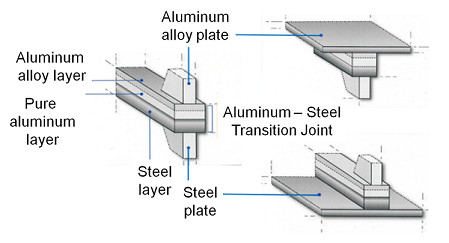| Sign In | Join Free | My himfr.com |
|
| Sign In | Join Free | My himfr.com |
|
| Ask Lasest Price | |
| Brand Name : | RUISEN |
| Delivery Time : | 60-90DAYS |
Steel And Aluminum Explosive Bonding Timetallic Transtion Joints Clad Strips For Shipbuilding

Advantages for shipbuilding and other structure connection purposes
Corrosion resistance:
Aluminum has good corrosion resistance, especially in marine
environments. By using aluminum-steel transition joints, the
structure can benefit from the corrosion resistance of aluminum in
areas exposed to seawater or other corrosive elements.
For example, on ship hulls, the use of these joints can help
prolong the lifespan of the vessel by reducing the effects of
corrosion.
Lightweight yet strong:
Aluminum is lighter than steel, which can help reduce the overall
weight of the ship or structure. This is crucial for improving fuel
efficiency in ships and making transportation and installation of
structures easier.
In shipbuilding, a lighter weight can increase cargo capacity or
improve the ship's speed and maneuverability.
Good electrical conductivity:
Aluminum has high electrical conductivity, which can be beneficial
in certain applications where electrical conduction is required.
For example, in some marine electrical systems, the use of aluminum
components connected by these transition joints can ensure
efficient electrical flow.
Cost-effective:
Although the initial cost of explosive welding transition joints
may be higher than traditional connection methods, their long-term
durability and performance can lead to cost savings over the life
of the ship or structure.
Reduced maintenance and repair costs due to better corrosion
resistance and strength can offset the initial investment.
Bimetallic or Triametallic transition joints accordingly.
- Steel (Q235B, 316L, 304) + Aluminum (AL1050 or 1060) + Aluminum alloy 5083
- Steel (Q235B, 316L, 304) + Aluminum (AL1050 or 1060) + Aluminum alloy 5083
Total thickness can be from 10 mm till 40 mm

The benefit of the last one combination is the ability for the interface to be heated up to 500 °C during fusion welding to ship structure. Meanwhile the first one combination interface can be heated only up to 300 °C

|




